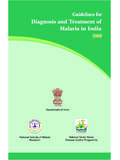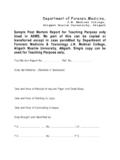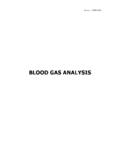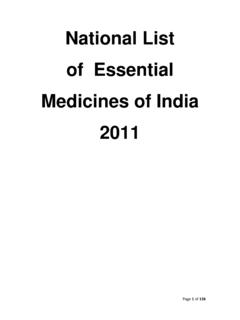Transcription of CONTENTS
1 CONTENTS . Chapter Name of the Chapter Page No. Preface (i). Acknowledgment (ii). List of contributors (iii). Chapter 1 Introduction 1-2. Introduction 1. Dengue in India 1-2. Chapter 2 Epidemiology 3-6. Epidemiology 3. Agent Factor 3. Vector 3-4. Environmental Factor 4-5. Host Factor 6. Transmission cycle 6. Chapter 3 Clinical Diagnosis of DHF/DSS 7-9. Immuno-pathogenesis 7. Clinical manifestation of DF/DHF 8-9. Chapter 4 Laboratory Diagnosis of Dengue 10-13. Laboratory Diagnosis 10. Isolation of Dengue Virus 10. Serological Tests 10. Haemagglutination inhibition (HI) test 11. Compliment Fixation Test (CFT) 11. Neutralization test (NT) 11. IgM Capture ELISA (Mac ELISA) 11-12.
2 IgG ELISA 12. Rapid Diagnosis Tests (RDTs) 12. Collection of Specimens 12-13. NVBDCP strategy for laboatory diagnosis 13. Chapter 5 Clinical management 14-24. Grading the severity of Dengue infection 14. Management 15. Management of Dengue fever (DF) 15-16. Management of DHF (Febrille Phase) 16. Management of DHF Grade I and II 16-17. Management of DHF Grade III and IV 17. Chart 1 Volume replacement flow chart for patients 18. with DHF Grades I & II. Chart 2 Volume replacement flow chart for patient 19. with DHF Grades III & IV. Criteria for discharge of patients 20. Requirement of Fluid 20-21. Ready Reckoner 22. Dengue corner 22. Indications for domiciliary management 22.
3 Admission of patient 23. Lab investigations for patients 23. Lab investigation for diagnosis 23. Investigation for indoor patients 23. Indoor management of patients 24. Indications of red cell transfusion 24. Indications of platelet transfusion 24. Use of fresh frozen plasma/ cryoprecipitate 24. Annexure I Checklist of diagnosis and therapeutic material for dengue cases management 25. Annexure II List of the Sentinel Hospitals/Apex Referral Laboratories for Dengue and Chikungunya 26-30. Annexure III Proforma for line listing 31. Annexure IV Lab. requistion form 32. Reference for further information 33. PREFACE. Dengue Fever/Dengue Haemorrhagic Fever is an acute viral disease having the potential of causing, large scale outbreaks.
4 The risk of dengue has shown an increase in recent years due to rapid, urbanization, life style changes and deficient water management including improper water storage practices in urban, peri-urban and rural areas, leading to proliferation of mosquito breeding sites. In India, the first evidence about the occurrence of dengue fever was reported during 1956 from Vellore district in Tamil Nadu. The first DHF outbreak occurred in Calcutta (Kolkata, West Bengal) in 1963 with 30% of cases showing haemorrhagic manifestations. In 1996, the country had experienced an outbreak recording a total number of 16517 cases (suspected) and 545 deaths. During 2003 as well, large number of cases and deaths had been reported (12754 and 215, respectively).
5 In the year 2006, there was again upsurge in DF/DHF cases in the country, with a total 11638 cases and 174 deaths reported by 21 states of the country. All the four serotypes Dengue 1, 2, 3 and 4 have been isolated in India. There is no specific treatment for dengue fever. Besides, the dengue vaccine has a long way to go. As any of the four dengue viruses can cause the disease, hence the vaccine must be tetravalent , it needs to protect against all four viruses. One of the primary problems in management of dengue is misinterpretation and resultant confusion because of the term haemorrhagic fever implying a significant haemorrhagic component to the patho-physiology and overshadowing the increased permeability, which causes depletion of the intravascular component.
6 The doctor managing a dengue patient has to make evaluations of the haemodynamic state to assess for judicious fluid replacement at several points of time. A broad-angled evaluation involves integration of clinical and laboratory parameters, which are in turn summation of the disease process as well as the ongoing treatment. This understanding is crucial in guiding decisions about the volume, rate and type of fluid infusion. Most, if not all, deaths due to dengue are potentially avoidable. Thus, it was essential to frame the common guidelines on Clinical Management of Dengue for the physicians across the country. These guidelines on clinical management of DF/DHF/DSS have been developed in consultation with the leading national and international experts in the field of clinical management of DHF.
7 I am sure these will guide the clinicians for appropriate treatment of the patients with DF/DHF /DSS and would help in reducing the case fatality rate of DHF/. DSS. These are only broad guidelines, the treating physician should consider the condition of the patient in totality and decide the course of treatment to save the life. (Dr. Dhillon). i ACKNOWLEDGMENTS. In recent years Dengue cases are increasing alarmingly in various parts of the country including rural areas. The disease is now endemic in 21 states/UTs. As the disease is spreading to newer areas, not only the number of cases and deaths are increasing, but explosive outbreaks are occurring.
8 In absence of any specific treatment or vaccine, proper management of cases is utmost crucial in dengue. Keeping the above in mind these guidelines on clinical management of DF/DHF/DSS has been developed during a brain storming workshop held on 14th & 15th March 2007 at AIIMS in collaboration with WHO SEARO. Many national and international leading experts in the field of clinical management of DF/DHF/DSS participated in this workshop and deliberated to frame the draft guidelines. NVBDCP gratefully acknowledge contributions and technical inputs of all the experts for developing these guidelines. Dr. Joshi, former Director, NVBDCP, is gratefully acknowledged for his keen interest in developing these guidelines for clinicians to bring about the nuances in dengue management and technical advice for undertaking the preparation of this document.
9 NVBDCP is extremely grateful to Dr. Suchitra Nimmannitya, Queen Sirikit National Institute of Child Health, Thailand, Bangkok for her experienced technical guidance while framing these guidelines. Valuable suggestion provided by Dr. Duane J Gubler, Director, Asia-Pacific Institute of Tropical Medicine and Infectious Diseases, John A Burns School of Medicine, University of Hawaii at Manoa , Honolulu, Hawaii is also gratefully acknowledged. Technical support from Dr Chusak Prasittisuk, CDC, WHO/SEARO, New Delhi is sincerely acknowledged. Financial support provided by WHO (SEARO/Country office, India) towards the conduction of the workshop at AIIMS is greatly acknowledged.
10 NVBDCP is grateful to the Faculty of Medicine, AIIMS, specially Dr. Ashutosh Biswas, who has taken a lead and made enormous effort to make the international workshop successful and for providing expert & technical inputs while framing these guidelines. We are also thankful to Dr. Randeep Guleria for his guidance. Efforts put in by Dr. Bimlesh Dhar Pandey, Sr. Resident, AIIMS and Dr. Joshi, Consultant, NVBDCP during the preparation of the draft guidelines is greatly appreciated. Technical scrutiny of the final draft by Dr. Veena Devgan, Hindu Rao Hospital; Dr. Gupta, VMMC & Safdarjung Hospital and Dr. Sharma, Dr R M L Hospital;. are gratefully acknowledged.














